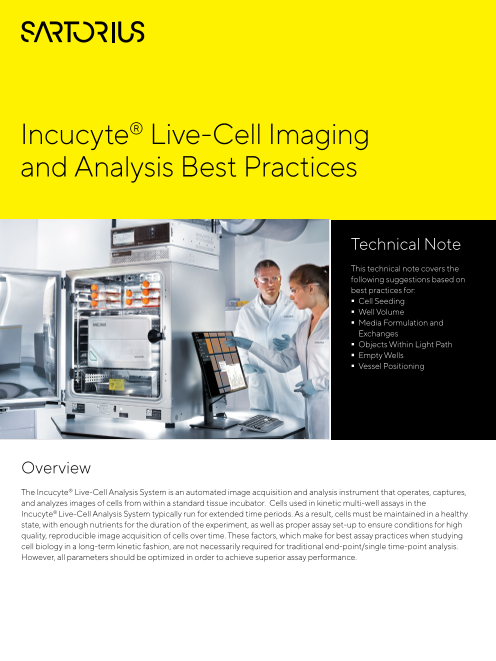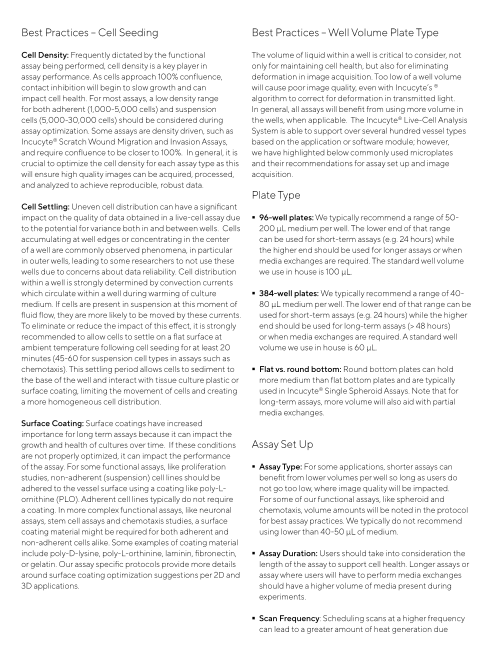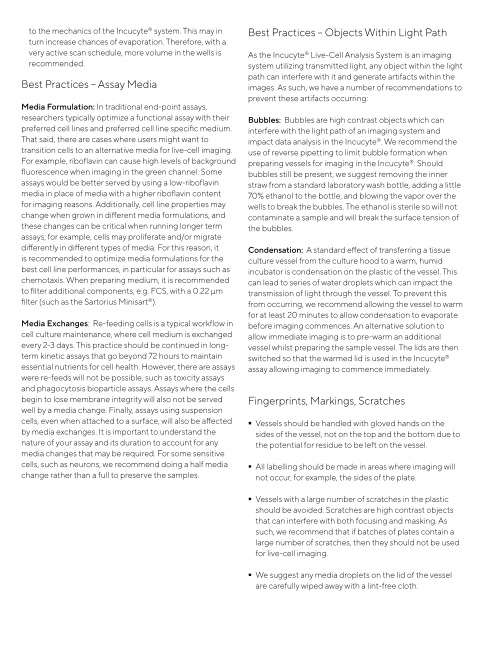1/5ページ
ダウンロード(401.1Kb)
このカタログについて
| ドキュメント名 | 【英語資料】Incucyte(R) ライブセル解析システム |
|---|---|
| ドキュメント種別 | その他 |
| ファイルサイズ | 401.1Kb |
| 取り扱い企業 | ザルトリウス・ジャパン株式会社 (この企業の取り扱いカタログ一覧) |
この企業の関連カタログ

このカタログの内容
Page1
Incucyte® Live-Cell Imaging
and Analysis Best Practices
Technical Note
This technical note covers the
following suggestions based on
best practices for:
Cell Seeding
Well Volume
Media Formulation and
Exchanges
Objects Within Light Path
Empty Wells
Vessel Positioning
Overview
The Incucyte® Live-Cell Analysis System is an automated image acquisition and analysis instrument that operates, captures,
and analyzes images of cells from within a standard tissue incubator. Cells used in kinetic multi-well assays in the
Incucyte® Live-Cell Analysis System typically run for extended time periods. As a result, cells must be maintained in a healthy
state, with enough nutrients for the duration of the experiment, as well as proper assay set-up to ensure conditions for high
quality, reproducible image acquisition of cells over time. These factors, which make for best assay practices when studying
cell biology in a long-term kinetic fashion, are not necessarily required for traditional end-point/single time-point analysis.
However, all parameters should be optimized in order to achieve superior assay performance.
Page2
Best Practices – Cell Seeding Best Practices – Well Volume Plate Type
Cell Density: Frequently dictated by the functional The volume of liquid within a well is critical to consider, not
assay being performed, cell density is a key player in only for maintaining cell health, but also for eliminating
assay performance. As cells approach 100% confluence, deformation in image acquisition. Too low of a well volume
contact inhibition will begin to slow growth and can will cause poor image quality, even with Incucyte’s ®
impact cell health. For most assays, a low density range algorithm to correct for deformation in transmitted light.
for both adherent (1,000-5,000 cells) and suspension In general, all assays will benefit from using more volume in
cells (5,000-30,000 cells) should be considered during the wells, when applicable. The Incucyte® Live-Cell Analysis
assay optimization. Some assays are density driven, such as System is able to support over several hundred vessel types
Incucyte® Scratch Wound Migration and Invasion Assays, based on the application or software module; however,
and require confluence to be closer to 100%. In general, it is we have highlighted below commonly used microplates
crucial to optimize the cell density for each assay type as this and their recommendations for assay set up and image
will ensure high quality images can be acquired, processed, acquisition.
and analyzed to achieve reproducible, robust data.
Plate Type
Cell Settling: Uneven cell distribution can have a significant
impact on the quality of data obtained in a live-cell assay due 96-well plates: We typically recommend a range of 50-
to the potential for variance both in and between wells. Cells 200 µL medium per well. The lower end of that range
accumulating at well edges or concentrating in the center can be used for short-term assays (e.g. 24 hours) while
of a well are commonly observed phenomena, in particular the higher end should be used for longer assays or when
in outer wells, leading to some researchers to not use these media exchanges are required. The standard well volume
wells due to concerns about data reliability. Cell distribution we use in house is 100 µL.
within a well is strongly determined by convection currents
which circulate within a well during warming of culture 384-well plates: We typically recommend a range of 40-
medium. If cells are present in suspension at this moment of 80 µL medium per well. The lower end of that range can be
fluid flow, they are more likely to be moved by these currents. used for short-term assays (e.g. 24 hours) while the higher
To eliminate or reduce the impact of this effect, it is strongly end should be used for long-term assays (> 48 hours)
recommended to allow cells to settle on a flat surface at or when media exchanges are required. A standard well
ambient temperature following cell seeding for at least 20 volume we use in house is 60 µL.
minutes (45-60 for suspension cell types in assays such as
chemotaxis). This settling period allows cells to sediment to Flat vs. round bottom: Round bottom plates can hold
the base of the well and interact with tissue culture plastic or more medium than flat bottom plates and are typically
surface coating, limiting the movement of cells and creating used in Incucyte® Single Spheroid Assays. Note that for
a more homogeneous cell distribution. long-term assays, more volume will also aid with partial
media exchanges.
Surface Coating: Surface coatings have increased
importance for long term assays because it can impact the
growth and health of cultures over time. If these conditions Assay Set Up
are not properly optimized, it can impact the performance
of the assay. For some functional assays, like proliferation Assay Type: For some applications, shorter assays can
studies, non-adherent (suspension) cell lines should be benefit from lower volumes per well so long as users do
adhered to the vessel surface using a coating like poly-L- not go too low, where image quality will be impacted.
ornithine (PLO). Adherent cell lines typically do not require For some of our functional assays, like spheroid and
a coating. In more complex functional assays, like neuronal chemotaxis, volume amounts will be noted in the protocol
assays, stem cell assays and chemotaxis studies, a surface for best assay practices. We typically do not recommend
coating material might be required for both adherent and using lower than 40-50 µL of medium.
non-adherent cells alike. Some examples of coating material
include poly-D-lysine, poly-L-orthinine, laminin, fibronectin, Assay Duration: Users should take into consideration the
or gelatin. Our assay specific protocols provide more details length of the assay to support cell health. Longer assays or
around surface coating optimization suggestions per 2D and assay where users will have to perform media exchanges
3D applications. should have a higher volume of media present during
experiments.
Scan Frequency: Scheduling scans at a higher frequency
can lead to a greater amount of heat generation due
Page3
to the mechanics of the Incucyte® system. This may in Best Practices – Objects Within Light Path
turn increase chances of evaporation. Therefore, with a
very active scan schedule, more volume in the wells is As the Incucyte® Live-Cell Analysis System is an imaging
recommended. system utilizing transmitted light, any object within the light
path can interfere with it and generate artifacts within the
Best Practices – Assay Media images. As such, we have a number of recommendations to
prevent these artifacts occurring:
Media Formulation: In traditional end-point assays,
researchers typically optimize a functional assay with their Bubbles: Bubbles are high contrast objects which can
preferred cell lines and preferred cell line specific medium. interfere with the light path of an imaging system and
That said, there are cases where users might want to impact data analysis in the Incucyte®. We recommend the
transition cells to an alternative media for live-cell imaging. use of reverse pipetting to limit bubble formation when
For example, riboflavin can cause high levels of background preparing vessels for imaging in the Incucyte®. Should
fluorescence when imaging in the green channel. Some bubbles still be present, we suggest removing the inner
assays would be better served by using a low-riboflavin straw from a standard laboratory wash bottle, adding a little
media in place of media with a higher riboflavin content 70% ethanol to the bottle, and blowing the vapor over the
for imaging reasons. Additionally, cell line properties may wells to break the bubbles. The ethanol is sterile so will not
change when grown in different media formulations, and contaminate a sample and will break the surface tension of
these changes can be critical when running longer term the bubbles.
assays; for example, cells may proliferate and/or migrate
differently in different types of media. For this reason, it Condensation: A standard effect of transferring a tissue
is recommended to optimize media formulations for the culture vessel from the culture hood to a warm, humid
best cell line performances, in particular for assays such as incubator is condensation on the plastic of the vessel. This
chemotaxis. When preparing medium, it is recommended can lead to series of water droplets which can impact the
to filter additional components, e.g. FCS, with a 0.22 µm transmission of light through the vessel. To prevent this
filter (such as the Sartorius Minisart®). from occurring, we recommend allowing the vessel to warm
for at least 20 minutes to allow condensation to evaporate
Media Exchanges: Re-feeding cells is a typical workflow in before imaging commences. An alternative solution to
cell culture maintenance, where cell medium is exchanged allow immediate imaging is to pre-warm an additional
every 2-3 days. This practice should be continued in long- vessel whilst preparing the sample vessel. The lids are then
term kinetic assays that go beyond 72 hours to maintain switched so that the warmed lid is used in the Incucyte®
essential nutrients for cell health. However, there are assays assay allowing imaging to commence immediately.
were re-feeds will not be possible, such as toxicity assays
and phagocytosis bioparticle assays. Assays where the cells
begin to lose membrane integrity will also not be served Fingerprints, Markings, Scratches
well by a media change. Finally, assays using suspension
cells, even when attached to a surface, will also be affected Vessels should be handled with gloved hands on the
by media exchanges. It is important to understand the sides of the vessel, not on the top and the bottom due to
nature of your assay and its duration to account for any the potential for residue to be left on the vessel.
media changes that may be required. For some sensitive
cells, such as neurons, we recommend doing a half media All labelling should be made in areas where imaging will
change rather than a full to preserve the samples. not occur, for example, the sides of the plate.
Vessels with a large number of scratches in the plastic
should be avoided. Scratches are high contrast objects
that can interfere with both focusing and masking. As
such, we recommend that if batches of plates contain a
large number of scratches, then they should not be used
for live-cell imaging.
We suggest any media droplets on the lid of the vessel
are carefully wiped away with a lint-free cloth.
Page4
Best Practices – Empty Wells
The Incucyte® Live-Cell Analysis System utilizes an
image based autofocusing approach to determine the
most appropriate z-plane in which to obtain an image by
assessing contrast levels throughout the z-axis. To optimize
this process, information from preceding wells is used to
inform the system as to the most likely focal plane in which
to image in subsequent wells. If however there are no cells
present within the well, there is the possibility that the
Incucyte® will struggle to find a focal plane or find contrast
in a focal plane away from that of the cells in downstream
wells leading to an out-of-focus image. To avoid this
possibility, and to speed up scan times, users can simply
select a scan pattern which corresponds only to the wells
which contain cells when setting up a vessel in the Add
Vessel guided interface within the software.
Best Practices – Vessel Positioning
When loading vessels into the Incucyte® Live-Cell Analysis
System, we recommend removing the metal tray which
holds the vessel from the Incucyte® gantry and placing it
on a flat surface. This allows correct positioning of vessels
in all trays and downwards pressure to be applied when
using multi-well plates, with well A1 positioned in the top left
corner. This is important for fixing a vessel in position due
to the ball bearings in this tray type which hold the vessel in
location. Inserting a vessel whilst in situ can lead to vessels
not being seated correctly within the tray. An exception to
this is the situation where a tray is already occupied with an
existing vessel. In this circumstance we would recommend
giving resistance to the underside of the tray, preventing
downward pressure being applied to the gantry arm and
allowing the vessel to be seated correctly without impacting
an existing experiment.
Page5
North America Europe Asia Pacific
Sartorius Corporation Sartorius UK Ltd. Sartorius Japan K.K.
565 Johnson Avenue Longmead Business Centre 4th Floor, Daiwa Shinagawa North Bldg.
Bohemia, NY 11716 Blenheim Road 1-8-11, Kita-Shinagawa 1-chome
USA Epsom Shinagawa-Ku
Phone +1 734 769 1600 Surrey, KT19 9QQ Tokyo 140-0001
United Kingdom Japan
Phone +44 1763 227400 Phone +81 3 6478 5202
Specifications subject to change without notice. © 2021. All rights reserved. Incucyte and all names of Sartorius products are registered trademarks and the property of Sartorius AG and/or
one of its affiliated companies. [ Incucyte-Live-Cell-Analysis-Tips-and-Tricks-Technical-Note-en-L-8000-0785-A00-Sartorius ] Status: 09| 2021








